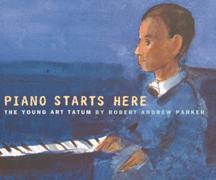Full Text Reviews: School Library Journal - 02/01/2008 K-Gr 4-Breathing life into words about music for young children is never easy, but Parker makes it appear effortless. Perhaps this is due, in part, to his own understandings as a jazz musician. His first-person account about the early years of Tatum's life is a feast for the senses. Beautifully paced, spare sentences accompany introductory watercolors of the legendary jazz pianist's family. Viewers watch the toddler on tiptoe reaching for the keys that provided delight to him from this early stage. As the narrative develops and Tatum's impaired vision begins to fade, the lines lengthen, incorporating the sounds, smells, and physical sensations that were much clearer to him. Listeners can imagine the scents of furniture polish and flowers as the boy plays in church or the vibration of his father's footsteps as he dances to his son's music in the living room. Parker's palette and style vary to create just the right ambience, with compositions ranging from a brightly lit snowscape with realistic figures racing down the path to moody, impressionistic backgrounds swirling around Tatum playing his beloved "Humoresque" on the road as a young man. Notes from the author describe his personal encounter with the musician and provide an overview of his life. A bibliography of adult resources is included; there is little available for children. Showcase this title with Chris Raschka's Charlie Parker Played Be Bop (Scholastic, 1992) and Andrea Davis Pinkney's Ella Fitzgerald (Hyperion, 2002) along with some CDs for a joint-jumping, heart-pumping ride.-Wendy Lukehart, Washington DC Public Library Copyright 2008 Reed Business Information. - Copyright 2008 Publishers Weekly, Library Journal and/or School Library Journal used with permission. Booklist - 02/01/2008 *Starred Review* Parker, who illustrated Jan Greenberg and Sandra Jordan’s Sibert Honor Book Action Jackson (2002), contributes both words and pictures in this heartfelt portrait of jazz great Tatum. Parker pushes the limits of the book’s nonfiction cataloguing by speaking in the pianist’s first-person voice, but an author’s note and a solid bibliography set the episodes in a framework of established facts. The vibrant scenes, in Parker’s familiar style of scratched ink lines and watercolor washes, show young Tatum playing at home for his dancing parents, at church for a full choir, and at local clubs, where he is discovered and his international career begins. In some images, crowds of dancers and musicians create a swirl of animated motion; in others, Parker sets Tatum, who was nearly blind, against a deep, moody, abstract background of shifting colors. Throughout, the simple, direct language shows the power of the music for both Tatum and his listeners. “When I am at the piano . . . I play clouds of notes, rivers of notes . . . I forget that my eyes aren’t good. I have everything I need.” Cue up the music; children will best appreciate this beautiful tribute with an earful of Tatum at the keyboard. - Copyright 2008 Booklist. Loading...
|



